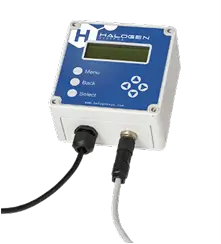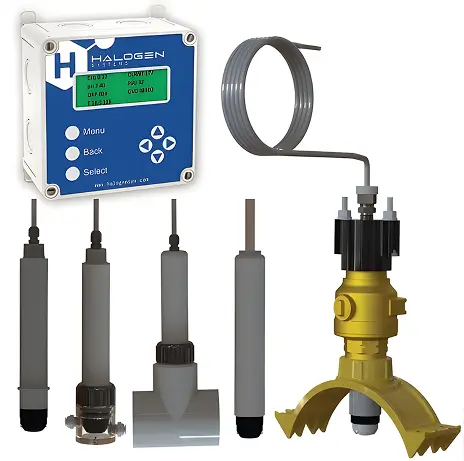Orange County Ironbridge
- Home
- Orange County Ironbridge
Orange County Ironbridge
- Home
- Orange County Ironbridge
Reclaimed Water Plant Finds Big Savings Opportunities During MP5™ Testing
An Orlando-owned water reclamation plant discovers huge upsides to replacing membrane and reagent sensor types with MP5™ models. While the old sensors required 3 calibrations per day the MP5™ required zero calibrations for 3 months.
An Orlando-owned water reclamation plant discovers huge upsides to replacing membrane and reagent sensor types with MP5™ models. While the old sensors required 3 calibrations per day the MP5™ required zero calibrations for 3 months.
Antonio Thompson, Chief Operator Iron Bridge Regional WRF City of Orlando, Florida
The Halogen HaloMP5 has been accurate for over 3 months without any calibration or maintenance. After installation, no calibration (of any of the parameters, including chlorine) was needed.

Trial at Iron Bridge Regional Wastewater Reclamation Facility
The Iron Bridge Regional Wastewater Reclamation Facility (Iron Bridge WRF) recently trialed the Halogen Systems MP5™ in a parallel loop to their existing sensor array. Reclaimed water is especially tough on Chlorine sensors, and their existing sensors needed to be calibrated once per shift—3 times per day per sensor. In the initial three months of operation, they were surprised to find the MP5™ required zero maintenance and no calibration. “The Halogen HaloMP5 has been accurate without any calibration or maintenance. After installation, no calibration (of any of the parameters, including chlorine) has been needed.” states the Chief Operator, Antonio Thompson. Iron Bridge WRF is a regional wastewater treatment plant that is operated and primarily owned by the City of Orlando. Much of the wastewater treated by Iron Bridge is from the City of Orlando. The huge plant is an important part of protecting the Central Florida environment, providing treatment for 27 million gallons per day with a total permitted capacity of 40MGD.
Effluent water flows directly into the St Johns river and a series of wetlands, so accuracy in testing is critical. There are many sensors for the oxidation portion of the process and their current line-up of sensors is maintenance-heavy due to the high demands placed by reclaimed water. Along with many other wastewater plants, choosing sensors for a Water Reclamation plant is a dilemma. Some reagent sensors don’t need to compensate for pH, but most require frequent replacement of the reagent solutions. Membrane sensors don’t require reagents, but the membranes must be replaced every three months or less and they need a metered flow and pressure to maintain calibration. That’s a real problem. Tightly controlling [flow and pressure] is often difficult in a wastewater facility. The MP5™ is designed to solve the sensor dilemma. It measures 5 parameters in one integrated package. It uses proprietary technology that maintains a stable calibration for months even in tough environments like water reclamation. Thompson describes the MP5™ as something new “with a three electrode, amperometric chlorine sensor, plus four additional parameters. The chlorine portion of the sensor uses bare electrodes, an integral pump, and a cleaning system using polymeric balls.
Trial at Iron Bridge Regional Wastewater Reclamation Facility



The MP5TM needed zero maintenance and no calibration for the first 3 months of installation
A common interface for all five parameters and a single manufacturer simplifies training
The MP5™ kept a stable calibration even in the tough environment dictated by a Water Reclamation plant.
Trial at Iron Bridge Regional Wastewater Reclamation Facility


The MP5TM needed zero maintenance and no calibration for the first 3 months of installation
A common interface for all five parameters and a single manufacturer simplifies training

The MP5™ kept a stable calibration even in the tough environment dictated by a Water Reclamation plant.
The long-term benefit for Iron Bridge will be the elimination of the cost and maintenance of a least three of these other discrete sensors, (besides the chlorine sensor), with the use of a single MP5

Multi-Parameter Monitoring: Eliminating Frequent Calibration
This has advantages. Jason Erskine of CL2 Solutions, a Florida-based consultancy specializing in the drinking water and wastewater industry, says “Since the sensor measures five parameters, three are used to compensate for changes in conductivity, temperature, and pH…This is one of the reasons why initial and frequent calibration are not needed.” The integral pump provides ease of installation. Thompson reports “The sensor was simply dropped into a tee with flowing water and oriented properly. Since the sensor is unaffected by changing flow, the installation method is quite flexible. And almost any flow condition will work. Even immersion is an option.” What about accuracy? Thompson notes “The existing chlorine analyzers require calibration on every shift (three times a day). The Halogen HaloMP5 has been accurate for over three months without any calibration or maintenance. Part of the reason for this may be the MP5’s self-cleaning feature. The sensor is continuously cleaned while operating.” Erskine estimates that the maintenance and calibration required for the current seven sensors are costing the plant more than 3,800 man-hours per year. Testing revealed other MP5™ pluses. “Other unanticipated benefits were the other parameters: pH, conductivity, temperature and ORP. These readings from the MP5 matched the other discrete sensors. While most pH sensors are damaged if left dry for more than a few hours, per the manufacturer, the MP5 pH sensor cartridge is undamaged if left in a dry pipe for days or weeks.” All these upsides give the Iron Bridge plant a clear path towards a more efficient process.
“The long-term benefit for Iron Bridge will be the elimination of the cost and maintenance of a least three of these other discrete sensors, (besides the chlorine sensor), with the use of a single MP5.” Cost savings are significant. “Fewer spares will be needed, and training will be simplified since there is only one manufacturer. The sensors performed out of the box without calibration so spare sensors can be simply swapped out if there is a suspected problem. There may be no need for the constant visits by technicians currently required to keep the equipment running properly.” Thompson’s conclusions are definitive. “If chlorine is used in their process, other Wastewater treatment plant operators should take notice of this new option. This new technology can save many man-hours, improve processes, and reduce cost, both CAPEX and OPEX, for plants. We believe that this technology is a huge leap forward for plant operators and we want to share our experience for the benefit of our industry and the environment.” Halogen looks forward to helping the team at Iron Bridge WRF maintain it’s goals to preserve the environment and to protect public health.
Since the sensor is unaffected by changing flow, the installation method is quite flexible. And almost any flow condition will work. Even immersion is an option.
Antonio Thompson,
Chief Operator